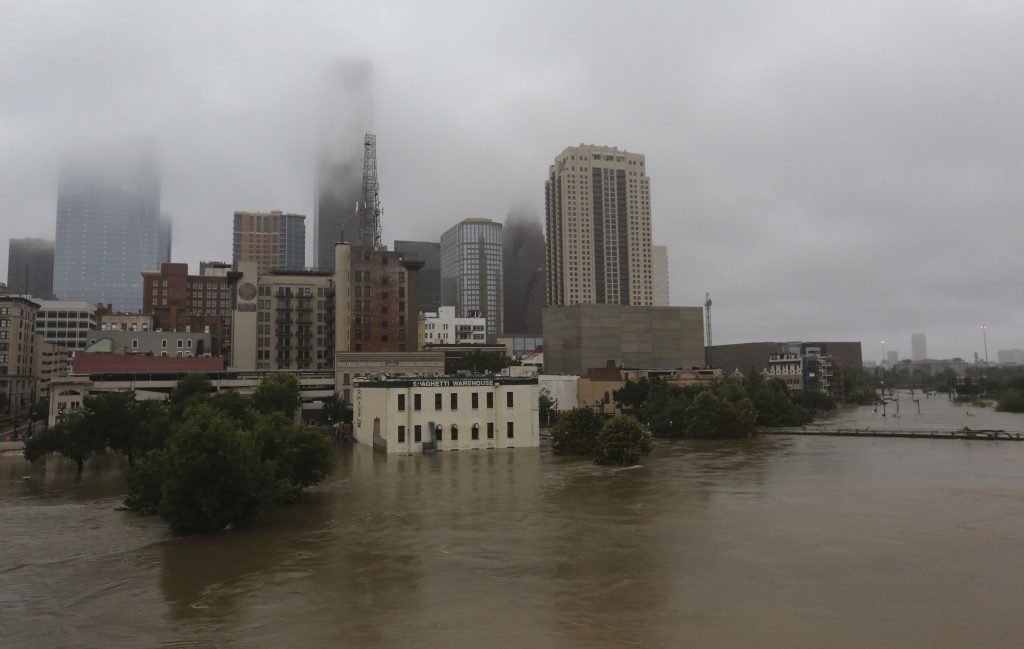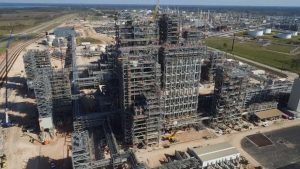
The effects of Storm Harvey could be felt in the US for a long time to come, but it won’t be noticed by the North Sea oil and gas industry.
Storm Harvey has swept along the US Gulf Coast leaving behind a trail of devastation for families and businesses.
At least two people have been killed, while ports, pipelines, platforms and refineries have been forced to close by the most powerful storm Texas has seen in more than half a century.
Operators have shut in about 380,000 barrels per day of oil output in the Gulf of Mexico, which equates to about a fifth of the total, according to a US Bureau of Safety and Environmental Enforcement survey.
And roughly 2.2million barrels per day of refining capacity has been taken offline.
Andrew Meyers, Houston-based associate director at energy consultancy Westwood Global, said storm Harvey was as damaging as anything seen in the region.
Mr Meyers said he had been forced to “hunker down” as record rainfalls continue to compound the impacts of the initial flooding.
Commenting on the oil sector, he said disruption to refineries would have the greatest impact on the Gulf Coast.
The area is home to about a third of US refining capacity.
The presence of such a large refining base partly explains why oil prices have not reacted well, despite the drop in production in the Gulf.
Usually, declining production forces crude prices upwards, as demand outstrips supply.
When Opec and non-Opec nations agreed to lower output from the start of this year, their aim was to increase crude prices.
But while gasoline prices are expected to rise as a result of the storm, Western Texas Intermediate (WTI) crude has dipped as refining capacity has been impacted.
The refineries are the consumers for the produced liquids. With the end-users out of action, it means demand is down.
As such, US WTI crude futures were down 3.4% to $46.23 at 4:36pm UK time yesterday.
Brent crude futures initially crept up, but the international benchmark had fallen 1.3% to $51.73 per barrel by late afternoon.
So, the reduction in refining capacity appears to have offset the drop in production, for the time being, at least.
But Brent prices could still be supported by the storm.
US shale has been Opec’s nemesis in its bid to increase crude prices, due to the sector’s ability to produce large quantities of fracked hydrocarbons at speed.
Harvey has caused US onshore operators to cease output from hundreds if not thousands of wells onshore, affecting 300,000 barrels per day of production.
The extent of flood-damage to these wells is not yet clear, but if it takes longer than expected to bring them back online, storm Harvey could end up doing more to boost oil prices than Opec’s hard-won agreements on production quotas.
However, a number of oil and gas experts have said any changes to crude prices resulting from the storm were unlikely to be significant or long-lasting.
Furthermore, any impact on the North Sea producers’ operations and balance sheets will be negligible.
Professor Paul de Leeuw, director of Robert Gordon University’s Oil and Gas Institute, said more time would be needed to assess the damage and any effects it might have on commodity prices.
Prof de Leeuw said: “Unfortunately the storm continues to have a material impact on the Gulf Coast region, affecting many people who live and work in the area.
“The weather has also had a significant impact on the refining capacity along the Gulf Coast and has already reduced the demand for crude oil by the refineries.
“This lower demand has reduced the price of WTI in the short term.
“In addition, the impact of the reduced refining capacity has increased the cost of refined products, such as petrol and diesel.
“The big question is: How much of the area’s refining and production capacity has been damaged and how quickly can it come back online?
“At this stage, it is simply too early to answer that.”
Professor Alex Kemp, a prominent, Aberdeen-based petro-economist, said the storm could yet have a significant impact on oil and gas production, particularly if offshore platforms are damaged.
Prof Kemp of Aberdeen University said: “Texas is a major producer of oil and gas. In fact, for onshore production it is the biggest single state in the US.
“That means any disruption to oil and gas production in Houston could have significant ramifications.
“There could also be problems with some offshore platforms. Any damage to producing installations will be noticed in the market.
“So oil and gas traders will be watching carefully and assessing the effects on production.
“It could lead to an increase in crude prices.”
But Prof Kemp agreed it was still too early to gauge the scale of the impact.
He said: “The extent of the impact on prices will depend on our knowledge of the damage being caused and the length of time taken to implement remedial measures.
“There have been quite a few storms over the years which have affected production in the Gulf of Mexico.
“Of course, in the case of onshore installations, if they are damaged, they take longer to repair.
“Onshore, damage should be repaired quickly, but if it’s a major platform in the Gulf of Mexico, then that can take quite a long time.
“I doubt the storm will result in crude prices increasing by a range of $5 to $10 per barrel, but it could increase by a few dollars.”
Prof Kemp also said any changes in crude prices resulting from the storm would be short-lived.
And Prof Kemp added that while oil prices may go up, North Sea producers should not expect much of a lift in revenues.
He said: “The effect on prices should be relatively short term. Traders may push prices up, but it’s unlikely to affect the long-term.
“As for the North Sea, the spot prices will probably go up and that will help companies in terms of their cash flow, while the UK Government’s take should also go up.
“But we should not extrapolate that into any long-term effects.
“North Sea investment decisions won’t be made because of a short-term price spike.”
Andrew Reid, Aberdeen-based president of consulting at Westwood Global, agreed that there would not be much of an upside for North Sea producers.
Mr Reid said: “There is an element of production being shut down in the US, but the impact mostly affects refining capacity.
“That will create some jitters on the market and we will see a strengthening of commodity prices.
“That said, I do not see the disruption being prolonged.”
“In all likelihood, the magnitude of supply disruption is not significant enough to cause a material uptick in oil prices.
“Nobody is going to make any investment decisions based on the changes we’re seeing.
“The North Sea is at the point just now where oil is around $50 per barrel. We still need to see significantly higher levels to unlock extra capital expenditure and new investment in the region.
“Harvey is not going to be a real catalyst for that.”
Mr Reid added: “Usually you find that markets react quickly to any kind of incident or news. In fact they overreact then stabilise.
“There should come a point when people understand the exact damage and how long capacity will be down.
“Over the course of this week prices will get back to normal levels.”
Recommended for you



